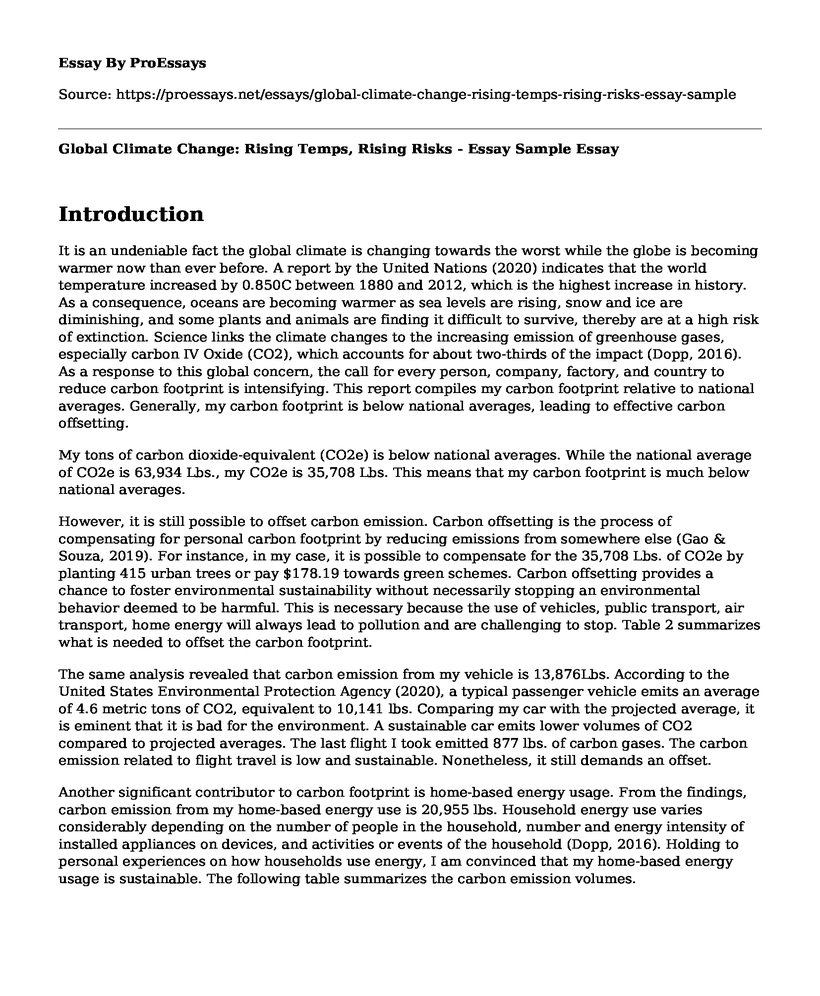Introduction
It is an undeniable fact the global climate is changing towards the worst while the globe is becoming warmer now than ever before. A report by the United Nations (2020) indicates that the world temperature increased by 0.850C between 1880 and 2012, which is the highest increase in history. As a consequence, oceans are becoming warmer as sea levels are rising, snow and ice are diminishing, and some plants and animals are finding it difficult to survive, thereby are at a high risk of extinction. Science links the climate changes to the increasing emission of greenhouse gases, especially carbon IV Oxide (CO2), which accounts for about two-thirds of the impact (Dopp, 2016). As a response to this global concern, the call for every person, company, factory, and country to reduce carbon footprint is intensifying. This report compiles my carbon footprint relative to national averages. Generally, my carbon footprint is below national averages, leading to effective carbon offsetting.
My tons of carbon dioxide-equivalent (CO2e) is below national averages. While the national average of CO2e is 63,934 Lbs., my CO2e is 35,708 Lbs. This means that my carbon footprint is much below national averages.
However, it is still possible to offset carbon emission. Carbon offsetting is the process of compensating for personal carbon footprint by reducing emissions from somewhere else (Gao & Souza, 2019). For instance, in my case, it is possible to compensate for the 35,708 Lbs. of CO2e by planting 415 urban trees or pay $178.19 towards green schemes. Carbon offsetting provides a chance to foster environmental sustainability without necessarily stopping an environmental behavior deemed to be harmful. This is necessary because the use of vehicles, public transport, air transport, home energy will always lead to pollution and are challenging to stop. Table 2 summarizes what is needed to offset the carbon footprint.
The same analysis revealed that carbon emission from my vehicle is 13,876Lbs. According to the United States Environmental Protection Agency (2020), a typical passenger vehicle emits an average of 4.6 metric tons of CO2, equivalent to 10,141 lbs. Comparing my car with the projected average, it is eminent that it is bad for the environment. A sustainable car emits lower volumes of CO2 compared to projected averages. The last flight I took emitted 877 lbs. of carbon gases. The carbon emission related to flight travel is low and sustainable. Nonetheless, it still demands an offset.
Another significant contributor to carbon footprint is home-based energy usage. From the findings, carbon emission from my home-based energy use is 20,955 lbs. Household energy use varies considerably depending on the number of people in the household, number and energy intensity of installed appliances on devices, and activities or events of the household (Dopp, 2016). Holding to personal experiences on how households use energy, I am convinced that my home-based energy usage is sustainable. The following table summarizes the carbon emission volumes.
Conclusion
In conclusion, the findings indicate that my family is doing a good job of limiting carbon concentration. Generally, the household's carbon emission level is much below the national average, pointing to environmental sustainability. However, there is a need for the family to find a more sustainable car with a low carbon footprint compared to the one it currently has. As of compensating for its carbon footprint, there is a need for the family to offset its emissions by either planting 415 urban trees of paying a total of $178.19 to a green program.
References
Dopp, K. A. (2016). Global warming, atmospheric carbon, and anthropogenic carbon emissions. SSRN Electronic Journal. https://doi.org/10.2139/ssrn.2803297
Gao, F., & Souza, G. (2019). Carbon offsetting with eco-conscious consumers. SSRN Electronic Journal. https://doi.org/10.2139/ssrn.3440652
United Nations. (2020, March 6). Climate change. Welcome to the United Nations. https://www.un.org/en/sections/issues-depth/climate-change/
The United States Environmental Protection Agency. (2020, February 18). Greenhouse gas emissions from a typical passenger vehicle. US EPA. https://www.epa.gov/greenvehicles/greenhouse-gas-emissions-typical-passenger-vehicle
Cite this page
Global Climate Change: Rising Temps, Rising Risks - Essay Sample. (2023, May 04). Retrieved from https://proessays.net/essays/global-climate-change-rising-temps-rising-risks-essay-sample
If you are the original author of this essay and no longer wish to have it published on the ProEssays website, please click below to request its removal:
- Why Should Human Beings Protect the Environment? - Essay Sample
- How Ecosystems Work Essay
- Super Volcano Apocalypse 2018
- Article Analysis Essay on Global Warming
- Park Rangers: Protecting Nature & Preserving Safety - Essay Sample
- Adapting Crops to Local Conditions for Maximum Yields - Essay Sample
- Essay on Gas Incident in Bhopal: An Accident With Deadly Consequences







